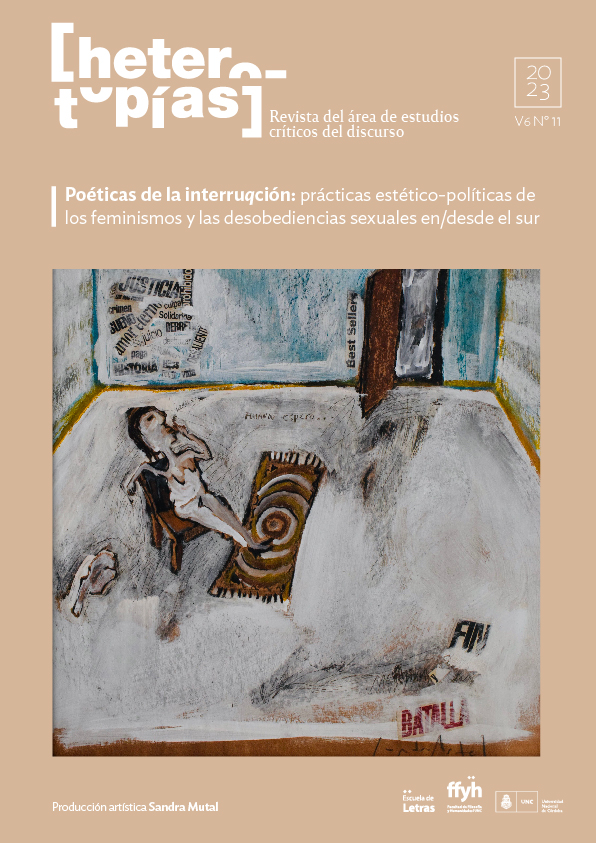El pliegue gótico/colonial en la narrativa de Liliana Colanzi
Main Article Content
Abstract
The article proposes a reading of the narrative of the Bolivian writer Liliana Colanzi from the
question of the ways in which the gothic repertoire is rhetorically intertwined with the
references to the relations of colonial domination on which the idea of nation is based. The
corpus is made up of four stories that are included in Nuestro mundo muerto (2017):
"Alfredito", "La Ola", "Meteorito" and "Chaco". In general lines, the work starts from the
analysis of the plot, the narrative voices and the construction of the intrigue in each of the
texts in order to reconstruct a series of metaphors that allude to a foundational violence that
makes the order (racial, sexual and moral) dominant and a subversive representation of
indigenous subjectivities.
Downloads
Article Details

This work is licensed under a Creative Commons Attribution-NonCommercial-ShareAlike 4.0 International License.
Those authors who have publications with this journal, accept the following terms: Those authors who have publications with this journal, accept the following terms:
a. The authors will keep their copyright and guarantee to the journal the right of first publication of their work, which will be simultaneously subject to the Creative Commons Attribution - Non-Commercial - Share Alike (by-nc-sa) Attribution License; no commercial use of the original work or any derivative works is allowed, the distribution of which must be done with a license equal to the one that regulates the original work.
b. Authors may adopt other non-exclusive license agreements for the distribution of the published version of the work (e.g., deposit it in an institutional telematic archive or publish it in a monographic volume) provided that the initial publication in this journal is indicated.
c. Authors are allowed and recommended to disseminate their work through the Internet (e.g. in institutional telematic archives or on their website) before and during the submission process, which may lead to interesting exchanges and increase the number of citations of the published work. (See The effect of open access).
How to Cite
References
Anderson, B. (1993). Comunidades imaginadas. Reflexiones sobre el origen y la difusión del nacionalismo. México: Fondo de Cultura Económica.
Añón, V. (2021). Colonialidad. En B. Colombi (Coord.), Diccionario de términos críticos de la literatura y la cultura en América Latina (pp. 103-113). Buenos Aires, Argentina: CLACSO.
Bajtín, M. (1989). Teoría y estética de la novela. Madrid, España: Taurus.
Bajtín, M. (1995). Estética de la creación verbal. Buenos Aires, Argentina: Siglo XXI.
Benjamin, W. (2000). El concepto de crítica de arte en el Romanticismo Alemán. Madrid, España: Península.
Bhabha, H. (2010). Nación y narración. Entre la ilusión de identidad y las diferencias culturales. Buenos Aires, Argentina: Siglo XXI.
Butler, J. (2010). Marcos de guerra. Las vidas lloradas. Barcelona, España: Paidós.
Capano, D. A. (2016). Campos de la narratología. Teoría y aplicación. Buenos Aires, Argentina: Biblos.
Colanzi, L. (2017). Nuestro mundo muerto. Buenos Aires, Argentina: Eterna Cadencia.
Cortés, J.M. (1997). Orden y caos. Un estudio cultural sobre lo monstruoso en las artes. Barcelona, España: Anagrama.
Deleuze, G. (1989). El pliegue. Leibniz y el Barroco. Barcelona, España: Paidós.
Eco, U. (2000). Lector in fabula. La cooperación interpretativa en el texto narrativo. Lumen.
Gasparini, S. (2022). “Aquí no me escucharán gritar”: violencia y horror en la narrativa latinoamericana reciente escrita por mujeres. Tesis (Lima), 15, 257-288. Recuperado de https://revistasinvestigacion.unmsm.edu.pe/index.php/tesis/article/view/23522
Genette, G. (1989). Figuras III. Barcelona, España: Lumen.
Giorgi, G. (2009). Política del monstruo. Revista Iberoamericana, 75(227), 323-329. Recuperado de https://revistaiberoamericana.pitt.edu/ojs/index.php/Iberoamericana/article/view/6575/0
González Almada, M. (2016). Territorialidades, textualidades. Torsiones y configuraciones en textos de Juan Pablo Piñeiro, Sebastán Antezana y Liliana Colanzi. Saga.
Revista de Letras, 6, 1-27. Rosario, Argentina. Recuperado de https://doi.org/10.35305/sa.v2i6.93
González Almada, M. (2018). Escrituras migrantes: desplazamientos identitarios u territoriales en textos de Magdalena Baudoin, Fabiola Morales y Liliana Colanzi. Cuadernos del Hipogrifo. Revista de literatura hispanoamericana y comparada, 10, 32-46. Roma. Recuperado de http://www.revistaelhipogrifo.com/?page_id=1557
Mariátegui, J.C. (2006). Siete ensayos de interpretación de la realidad peruana. Buenos Aires, Argentina: El Andariego.
Negroni, M. (2011). Los bordes del fantástico. Diálogo con María Negroni. Cuadernos Sigmund Freud, 27, 279-291.
Nofal, R. (2014). La guardarropía revolucionaria en la escritura de Laura Alcoba. El taco en la brea, 1, 277-287. Recuperado de https://bibliotecavirtual.unl.edu.ar/publicaciones/index.php/ElTacoenlaBrea/article/view/4217
Nofal, R. (2021). La divergencia del entrelugar en los personajes de Stella Manhattan de Silviano Santiago. Heterotopías. Revista del área de estudios críticos del discurso, 4(7), 1-11. Córdoba, Argentina. Recuperado de https://revistas.unc.edu.ar/index.php/heterotopias/article/view/33736
Piñeiro, J.P. (2010). Illimani púrpura. La Paz, Bolivia: 3600.
Piñeiro, J.P. (2014). Cuando Sara Chura despierte. Córdoba, Argentina: Portaculturas.
Quijano, A. (2014). Cuestiones y horizontes. De la dependencia histórico-estructural a la colonialidad/decolonialidad del poder. Buenos Aires, Argentina: CLACSO.
Rivera Cusicanqui, S. (2010). Ch´ixinakax utxiwa. Una reflexión sobre prácticas y discursos descolonizadores. Buenos Aires, Argentina: Tinta Limón.
Saint André, E. y Rolón, A. (2002). Semiótica y pragmática. Signos y relaciones entre signos. En E. Saint André (Coord.), Leer la novela hispanoamericana del siglo XX (pp.57-83). San Juan, Argentina: EFFHA.
Saona, M. (2004). Novelas familiares: figuraciones de la nación en la novela latinoamericana contemporánea. Rosario, Argentina: Beatriz Viterbo.
Seifert, M. (2021). El país de la selva: la bruja y el gótico mesopotámico en “Tela de araña” de Mariana Enríquez. Cuadernos del CILHA, 34, 1-21. Recuperado de https://revistas.uncu.edu.ar/ojs3/index.php/cilha/article/view/3781
Speddign, A. (2004). De vez en cuando Saturnina. La Paz, Bolivia: Mama Huaco.
Stefani, I. (2022). “Solo los indios creen en esas cosas”: significación del sujeto indígena en “Soroche” de Mónica Ojeda y “Chaco” de Liliana Colanzi. Orillas. Revista d´Ispanistica, 11, 61-72. Padua, Italia. Recuperado de http://www.orillas.net/orillas/index.php/orillas/article/view/474
Williams, R. (2009). Marxismo y Literatura. Buenos Aires, Argentina: Las cuarenta.
